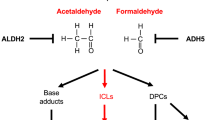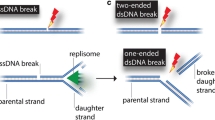Abstract—The important role of DNA damage in the occurrence of various diseases, including cancer, has led to study of the mechanisms of genetic information stability, that have been carried out since the discovery of DNA repair systems. The question of the relationship between the accumulation of DNA damage, disorders in DNA repair pathways, and increased risk of disease development is still relevant. Over the past few years, significant efforts have been made to develop methods for analyzing the activity of DNA repair enzymes in human cells. In this work, we developed fluorescent DNA probes that allow us to determine the activity of key enzymes of base excision DNA repair in cell extracts, namely the DNA glycosylases UNG2, SMUG1, MBD4, TDG, AAG, NEIL1, NTHL1, and OGG1 and the AP endonuclease APE1. The sensitivity of DNA probes was determined on pure enzyme preparations. Determination of the activity of repair enzymes in cell extracts of the human ovarian tumor lines TOV112, 79, OVCAR3, MESOV, SCOV3, and TOV21 revealed significant variability in the level of enzyme activity in these cell lines. These results may become a test system platform for analyzing the activity of the base excision DNA repair system in the human body.








Similar content being viewed by others
REFERENCES
Krokan H.E., Bjørås M. 2013. Base excision repair. Cold Spring Harb. Perspect. Biol. 5, a012583.
Dianov G., Price A., Lindahl T. 1992. Generation of single-nucleotide repair patches following excision of uracil residues from DNA. Mol. Cell. Biol. 12, 1605–1612.
Matsumoto Y., Bogenhagen D.F. 1994. Proliferating cell nuclear antigen-dependent abasic site repair in Xenopus laevis oocytes: an alternative pathway of base excision DNA repair. Mol. Cell. Biol. 14, 6187–6197.
Frosina G., Fortini P., Rossi O., Carrozzino F., Raspaglio G., Cox L.S., Lane D.P., Abbondandolo A., Dogliotti E. 1996. Two pathways for base excision repair in mammalian cells. J. Biol. Chem. 271, 9573–9578.
Klungland A., Lindahl T. 1997. Second pathway for completion of human DNA base excision-repair: reconstitution with purified proteins and requirement for DNase IV (FEN1). EMBO J. 16, 3341–3348.
Kim Y.-J., Wilson D.M. III. 2012. Overview of base excision repair biochemistry. Curr. Mol. Pharmacol. 5, 3–13.
Wiederhold L., Leppard J.B., Kedar P., Karimi-Busheri F., Rasouli-Nia A., Weinfeld M., Tomkinson A.E., Izumi T., Prasad R., Wilson S.H. 2004. AP endonuclease-independent DNA base excision repair in human cells. Mol. Cell. 15, 209–220.
Das A., Wiederhold L., Leppard J.B., Kedar P., Prasad R., Wang H., Boldogh I., Karimi-Busheri F., Weinfeld M., Tomkinson A.E., Wilson S.H, Mitra S. 2006. NEIL2-initiated, APE-independent repair of oxidized bases in DNA: evidence for a repair complex in human cells. DNA Repair (Amst.). 5, 1439–1448.
Cleaver J.E. 1968. Defective repair replication of DNA in Xeroderma pigmentosum. DNA Repair (Amst.). 3, 183–187.
Setlow R.B., Regan J.D., German J., Carrier W.L. 1969. Evidence that Xeroderma pigmentosum cells do not perform the first step in the repair of ultraviolet damage to their DNA. DNA Repair (Amst.). 3, 188–195.
Helleday T., Eshtad S., Nik-Zainal S. 2014. Mechanisms underlying mutational signatures in human cancers. Nat. Rev. Genet. 15, 585–598.
Grin I.R., Konorovsky P.G., Nevinsky G.A., Zharkov D.O. 2009. Heavy metal ions affect the activity of DNA glycosylases of the Fpg family. Biochemistry (Moscow). 74, 1253–1259.
Kreklau E.L., Limp-Foster M., Liu N., Xu Y., Kelley M.R., Erickson L.C. 2001. A novel fluorometric oligonucleotide assay to measure O 6-methylguanine DNA methyltransferase, methylpurine DNA glycosylase, 8-oxoguanine DNA glycosylase and abasic endonuclease activities: DNA repair status in human breast carcinoma cells overexpressing. Nucleic Acids Res. 29, 2558–2566.
Dianov G.L. 2003. Monitoring base excision repair by in vitro assays. Toxicology. 193, 35–41.
Weiss J.M., Goode E.L., Ladiges W.C., Ulrich C.M. 2005. Polymorphic variation in hOgg1 and risk of cancer: a review of the functional and epidemiologic literature. Mol. Carcinog. 42, 127–141.
Lee A.J., Hodges N.J., Chipman J.K. 2005. Interindividual variability in response to sodium dichromate-induced oxidative DNA damage: role of the Ser 326 Cys polymorphism in the DNA-repair protein of 8-oxo-7,8-dihydro-2'-deoxyguanosine DNA glycosylase 1. Cancer Epidemiol. Biomarkers Prev. 14, 497–505.
Xia L., O’Connor T.R. 2001. DNA glycosylase activity assay based on streptavidin paramagnetic bead substrate capture. Anal. Biochem. 298, 322–326.
Liu B., Yang X., Wang K., Tan W., Li H., Tang H. 2007. Real-time monitoring of uracil removal by uracil-DNA glycosylase using fluorescent resonance energy transfer probes. Anal. Biochem. 366, 237–243.
Wang X., Hou T., Lu T., Li F. 2014. Autonomous exonuclease iii-assisted isothermal cycling signal amplification: a facile and highly sensitive fluorescence DNA glycosylase activity assay. Anal. Chem. 86, 9626–9631.
Chen C., Zhou D., Tang H., Liang M., Jiang J. 2013. A sensitive, homogeneous fluorescence assay for detection of thymine DNA glycosylase activity based on exonuclease-mediated amplification. Chem. Commun. 49, 5874.
Cao X., Sun Y., LuP., Zhao M. 2020. Fluorescence imaging of intracellular nucleases—a review. Anal. Chim. Acta. 1137, 225–237.
Mirbahai L., Kershaw R.M., Green R.M., Hayden R.E., Meldrum R.A., Hodges N.J. 2010. Use of a molecular beacon to track the activity of base excision repair protein OGG1 in live cells. DNA Repair (Amst.). 9, 144–152.
Belhadj S., Rentsch A., Schwede F., Paquet-Durand F. 2021. Fluorescent detection of PARP activity in unfixed tissue. PLoS One. 16, 1–13.
Torchinsky D., Michaeli Y., Gassman N.R., Ebenstein Y. 2019. Simultaneous detection of multiple DNA damage types by multi-colour fluorescent labelling. Chem. Commun. 55, 11414–11417.
Hu J., Liu M.-H., Li Y., Tang B., Zhang C.-Y. 2018. Simultaneous sensitive detection of multiple DNA glycosylases from lung cancer cells at the single-molecule level. Chem. Sci. 9, 712–720.
Maksimenko A., Ishchenko A.A., Sanz G., Laval J., Elder R.H., Saparbaev M.K. 2004. A molecular beacon assay for measuring base excision repair activities. Biochem. Biophys. Res. Commun. 319, 240–246.
Pearl L.H., Schierz A.C., Ward S.E., Al-Lazikani B., Pearl F.M.G. 2015. Therapeutic opportunities within the DNA damage response. Nat. Rev. Cancer. 15, 166–180.
Zhang Y., Li C.-C., Zhang X., Xu,Q., Zhang C.-Y. 2020. Development of oxidation damage base-based fluorescent probe for direct detection of DNA methylation. Anal. Chem. 92, 10223–10227.
Liu G., He W., Liu C. 2019. Sensitive detection of uracil-DNA glycosylase (UDG) activity based on terminal deoxynucleotidyl transferase-assisted formation of fluorescent copper nanoclusters (CuNCs). Talanta. 195, 320–326.
Suggitt M., Fearnley J., Swaine D., Volpato M., Phillips R., Bibby M., Loadman P., Anderson D., Anderson D. 2003. Comet assay and flow cytometry analysis of DNA repair in normal and cancer cells treated with known mutagens with different mechanisms of action. Teratog. Carcinog. Mutagen. 2, 13–29.
Fasman G.D. 1975. Handbook of Biochemistry and Molecular Biology. 3rd ed. Cleveland: CRC.
Miroshnikova A.D., Kuznetsova A.A., Kuznetsov N.A., Fedorova O.S. 2016. Thermodynamics of damaged DNA binding and catalysis by human AP endonuclease 1. Acta Naturae. 8, 103–110.
Kuznetsova A.A., Fedorova O.S., Kuznetsov N.A. 2018. Kinetic features of 3'–5' exonuclease activity of human AP-endonuclease APE1. Molecules. 23, 2101.
Kuznetsova A.A., Kuznetsov N.A., Ishchenko A.A., Saparbaev M.K., Fedorova O.S. 2014. Step-by-step mechanism of DNA damage recognition by human 8‑oxoguanine DNA glycosylase. Biochim. Biophys. Act-a. 1840, 387–395.
Kuznetsov N.A., Koval V.V., Fedorova O.S. 2011. Mechanism of recognition and repair of damaged DNA by human 8-oxoguanine DNA glycosylase hOGG1. Biochemistry (Moscow). 76, 118–130.
Kuznetsova A.A., Iakovlev D.A., Misovets I.V., Ishchenko A.A., Saparbaev M.K., Kuznetsov N.A., Fedorova O.S. 2017. Pre-steady-state kinetic analysis of damage recognition by human single-strand selective monofunctional uracil-DNA glycosylase SMUG1. Mol. Biosyst. 13, 2638–2649.
Kuznetsov N.A., Kiryutin A.S., Kuznetsova A.A., Panov M.S., Barsukova M.O., Yurkovskaya A.V., Fedorova O.S. 2017. The formation of catalytically competent enzyme-substrate complex is not a bottleneck in lesion excision by human alkyladenine DNA glycosylase. J. Biomol. Struct. Dyn. 35, 950–967.
Kladova O.A., Grin I.R., Fedorova O.S., Kuznetsov N.A., Zharkov D.O. 2019. Conformational dynamics of damage processing by human DNA glycosylase NEIL1. J. Mol. Biol. 431, 1098–1112.
Kladova O.A., Iakovlev D.A., Groisman R., Ishchenko A.A., Saparbaev M.K., Fedorova O.S., Kuznetsov N.A. 2020. An assay for the activity of base excision repair enzymes in cellular extracts using fluorescent DNA probes. Biochemistry (Moscow). 8, 480‒489.
Kladova O.A., Alekseeva I.V., Saparbaev M., Fedorova O.S., Kuznetsov N.A. 2020. Modulation of the apurinic/apyrimidinic endonuclease activity of human APE1 and of its natural polymorphic variants by base excision repair proteins. Int. J. Mol. Sci. 21, 7174.
Kladova O.A., Bazlekowa-Karaban M., Baconnais S., Piétrement O., Ishchenko A.A., Matkarimov B.T., Iakovlev D.A., Vasenko A., Fedorova O.S., Le Cam E. 2018. The role of the N-terminal domain of human apurinic/apyrimidinic endonuclease 1, APE1, in DNA glycosylase stimulation. DNA Repair (Amst.). 64, 10–25.
Saparbaev M., Langouet S., Privezentzev C. V, Guengerich F.P., Cai H., Elder R.H., Laval J. 2002. 1,N(2)-ethenoguanine, a mutagenic DNA adduct, is a primary substrate of Escherichia coli mismatch-specific uracil-DNA glycosylase and human alkylpurine-DNA-N-glycosylase. J. Biol. Chem. 277, 26987–26993.
O’Brien P.J., Ellenberger T. 2004. Dissecting the broad substrate specificity of human 3-methyladenine-DNA glycosylase. J. Biol. Chem. 279, 9750–9757.
Ringvoll J., Moen M.N., Nordstrand L.M., Meira L.B., Pang B., Bekkelund A., Dedon P.C., Bjelland S., Samson L.D., Falnes P.Ø. 2008. AlkB homologue 2-mediated repair of ethenoadenine lesions in mammalian DNA. Cancer Res. 68, 4142–4149.
Kuznetsov N.A., Kanazhevskaya L.Y., Fedorova O.S. 2021. DNA demethylation in the processes of repair and epigenetic regulation performed by 2-ketoglutarate-dependent DNA dioxygenases. Int. J. Mol. Sci. 22, 10540.
Funding
This work was supported by the Russian Science Foundation (grant no. 21-14-00018) and with partial support from the budget funding project no. 121031300041-4.
Author information
Authors and Affiliations
Corresponding author
Ethics declarations
The authors declare no conflicts of interest. This article does not contain any studies involving humans or animals as research subjects.
Additional information
Abbreviations: OGG1, 8-oxoguanine DNA glycosylase; AAG, alkyl adenine DNA glycosylase; APE1, human AP endonuclease 1; MBD4, methylcytosine-binding domain 4; TDG, thymine DNA glycosylase; NEIL1, endonuclease VIII; AP site, apurine/apyrimidine site; F, (2R.3S)-2-(hydroxymethyl)-3-hydroxytetrahydrofuran residue; εА, 1,N6-ethenoadenosine; oxoG, 7,8-dihydro-8-oxoguanosine; FRET, Förster resonance energy transfer; Tg, thymidine glycol; FAM, 5(6)-carboxyfluorescein; BHQ1, black hole quencher; ps, thiophosphate group.
Rights and permissions
About this article
Cite this article
Alekseeva, I.V., Kuznetsova, A.A., Kladova, O.A. et al. DNA Probes for Analysis of the Activity of Key Enzymes of the Base Excision DNA Repair Pathway in Human Cells. Mol Biol 57, 299–311 (2023). https://doi.org/10.1134/S0026893323020024
Received:
Revised:
Accepted:
Published:
Issue Date:
DOI: https://doi.org/10.1134/S0026893323020024




